I have been in the jewelry business since 1970 when I bought my first gemstone for a girlfriend in Rio de Janeiro, Brazil. Within days I was buying & selling gems and my lifelong love affair and study of gemology was started. I graduated from the Gemological Institute of America in 1975, and have been a proud member of the trade ever since.
The purpose of this article is to show you how cameras can be a useful tool, but while they may not lie, they might often tell you different truths, and thus should not be used as the only selection tool in choosing your diamond or other gemstones.
The more I photograph diamonds, the more that I realize different equipment, lighting and camera settings can make the same gem look different. Unlike ASET® and Ideal-Scope® images, which are often standardized to allow photographic comparisons, “real world” photos and videos have no such standardization. Consumers hoping to make intelligent buying decisions should be made aware of the advantages and limitations of non-standardized photos and videos of diamonds. In this article I will post several examples to illustrate this.
Using the camera as a tool – not an absolute
Please take a moment to watch this video as an introduction. It is just over 2 minutes long and is very illustrative of the problems that can be seen with cameras.
“Flash content”I find it incredibly interesting that the same diamond can look so different, even when the same camera is used as in the “second and third diamonds” in that video, but especially when different cameras are used. The “second and third diamonds” were shot through the same camera, but using different software with startlingly different results.
The above video was taken of the same diamond; a 0.72ct D-VS1. The first camera is a Bodelin Proscope that I have used for a couple of years. It is actually the same camera that is used by many CSI units across the country (Yes, Virginia, there really is a Santa Claus – just like there are REAL CSI units – not just those seen on television…). The second camera is a Dinolite 411T which is marketed through
www.thelittlecameras.com. It is a fabulous little camera for still and video images and I include the link for any one who needs one, although I really hope my competitors do not read this article…
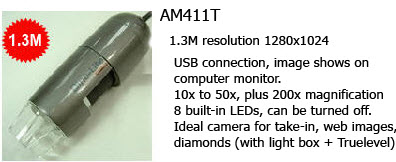
I am also going to include several shots taken with still cameras; one that I have used for years, and one that I am just now beginning to understand. The first is the Panasonic KR222; basically a hospital hallway surveillance camera that I have had slaved to my computer for seven or eight years through a flashbus twain interface that I will never again have to mess with.
The second is my new Nikon D-300 with 105mm telephoto lens with macro filter that is now slaved to my computer via Nikon Camera Control Pro 2. It allows me to set up a diamond in my light box and take various exposures without having to move my diamond at all or touch the camera. I can even focus through the computer so that no camera movement is introduced at any point in the photography.
Four Photos
I am going to start by sharing with you four photos of one diamond, a 1.77ct M-SI2 round brilliant. Here is the first, from the HPDiamonds.com website, in which this loupe photo shows with extreme prejudice all of the clarity characteristics in this diamond. It actually makes the diamond look horrible!
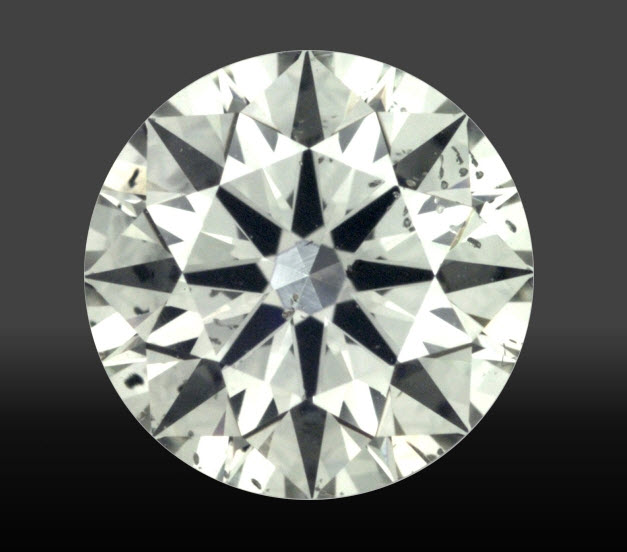
To look at this photo, you might think the diamond was a middle-to-low I1, yet is it not! It is the loupe photo, expanded to allow you to see all that is inside the diamond, much more than you will ever see with the unaided eye, and the camera and method of photography exaggerate the inclusions.
The next photo is taken with my old Panasonic camera.
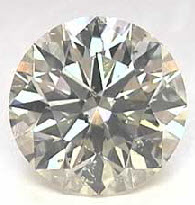
The diamond is still pretty lifeless and, although not in black and white, it certainly does not show the colors I see which are rampant in the diamond. More on that later, it was referred to in the video above, but we will go into it at length in a short while. Oh, and yes, the inclusions are still exaggerated; it still looks like an I1 in the magnified photo.
These last two pictures I will show you right now for this diamond were taken with my Nikon D-300 and they actually allows me to share
some of the beauty of this diamond. The one on the left was taken with an F/3.5 F/stop and the one on the right with F/25.
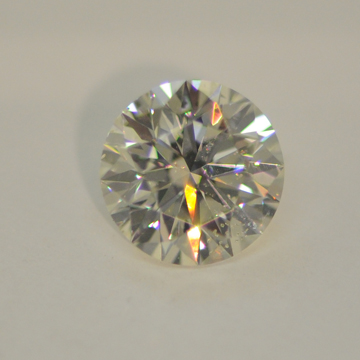
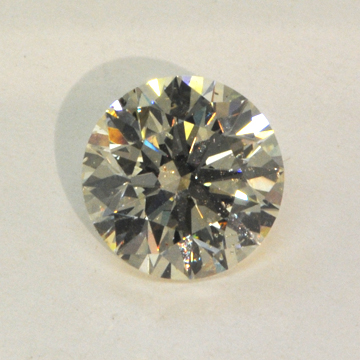
Which of these diamonds would excite you if you found them on four different websites?
Over the past several weeks, I have shown the last two photos to several people in my office and asked them which one they liked better. Several preferred the one on the left for its bright “flame of fire” coming from the lower pavilion main facet, others preferred the one on the right, it just seemed to have more “character and flashes of color” and was not as yellowish.
So, which of these photos is an attractive photo? Which one is an accurate photos? Which can we use to select our diamonds?
All of them? None of them? Oh, and
WHY DO THEY ALL LOOK SO DIFFERENT???
Technical Differences
Okay, here is where the science stuff comes in and since I am not a scientist, I will speak in layman’s terms about dispersion and how it is observed by the human eye.
When light enters an optically dense medium, such as water or a diamond, it bends as shown in this familiar drawing of a prism.
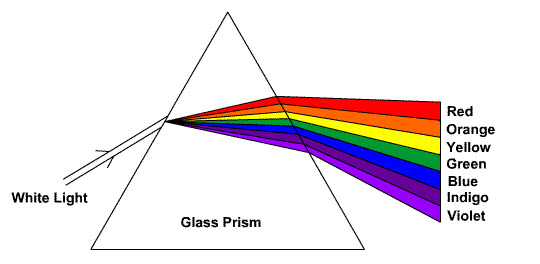
Here is the tricky part. As the light enters the prism (optically dense medium) it begins to disperse. As it leaves the prism, it disperses even further, making the lovely rainbow on the walls that we saw as kids when we played with prisms.
As you can imagine, when a wave of white light enters into a diamond, it has many more options to be lead astray and can be broken in to tens of thousands of rays within the diamond. In fact, it is this dispersion within the diamond that makes all the virtual facets possible (virtual facets are like looking into a mirror at the barbershop – does anyone still go to the barbershop? – when there is another mirror behind you and it seems like there are thousands of you each smaller than the last until you fade into infinity getting smaller and smaller). From these tens of thousands of virtual facets, the light is reflected until it is refracted from the diamond and resumes its journey, some of it as white light, and some of it as dispersion as shown above.
Now enter in the eye, more importantly the pupil of the eye, or the aperture of the camera.

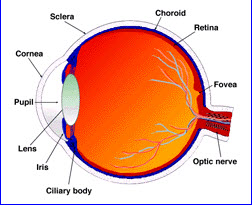
If, at the pupil of the eye, the dispersed area of the ray of light is wider than the pupil, the light will be perceived of as colored light, or dispersion. With the prism this is easy, as the light is bent very strongly both going in and coming out of the prism, and with a minimum of interference. It is a wide ray, and even at the edge of the prism it would likely be visible should you put your eye up to it.
However, if at the pupil of the eye, or the aperture of the camera, the ray of dispersed light is shorter than the width of the pupil of the eye, then the light is recombined and perceived of as white light, which is actually light that is made up of all of the colors together.
This picture of the relative size of two different f/stops will help understand why different cameras can show such different views of the same diamond. The aperture on your eye opens up in the dark to let more light in. This is why you will normally see less dispersion at night. With a camera we can use a smaller aperture and a longer shutter speed to get the right amount of light for a good photo.We can also adjust depth of field in this way to allow more of the diamond or jewelry to be in focus.
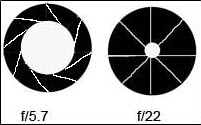
Since a diamond is usually a fairly small object in mm size, and they are normally looked at from fairly close distances, and since the dispersion of the ray going into the diamond will create literally tens of thousands of virtual facets, most of which are too small to be observable to the unaided eye, it is easy to understand that many of the dispersive rays will be fairly narrow by the time the reach either the aperture of the camera or the pupil of the eye and this light may well be observed as white light,
depending on the width of the pupil of the eye, or the aperture of the camera.
Thus, if you look back to the picture I took above with the f/3 f/stop, the aperture was large and small dispersive events were perceived by the camera as white light. The huge event off one of the lower pavilion mains was seen in this picture as a wonderful yellow and orange flair of dispersion off one of the arrow shafts and orange and white off of the corresponding arrow head.
This is proof by the way that the diamond was not perfectly perpendicular to the camera, as normally that facet would be part of the obstruction pattern that is observed in a hearts and arrows viewer. Part of the magic though is that as the diamond is tilted one way or another, facets that are off light up, and facets that are on become obstructed, which is what gives us the incredible scintillation that we treasure in a diamond.
Looking again at the photo beside that one that was taken with an f/stop of f/25 you will see a myriad of smaller dispersion events with more colors, and sadly, the wonderful yellow flair has for some reason disappeared. Perhaps the part that hit the wider aperture is now outside the much smaller opening of the f/25. I do not know the answer to this, perhaps also the camera or the stone moved a fraction of a mm due to vibration, I do not have the equipment or the training to measure or answer that question.
I do know that I took several pictures before getting the one with the flash of yellow that I could see at all times through the view finder. It was only when I opened it up to the f/3 that the flash remained.
Composite
Just for fun, here is a composite photo of the same diamond showing a total of six different shots, including one from my old camera. Each and every photo has a different flavor, and in the five taken with my D-300 only the aperture was changed.
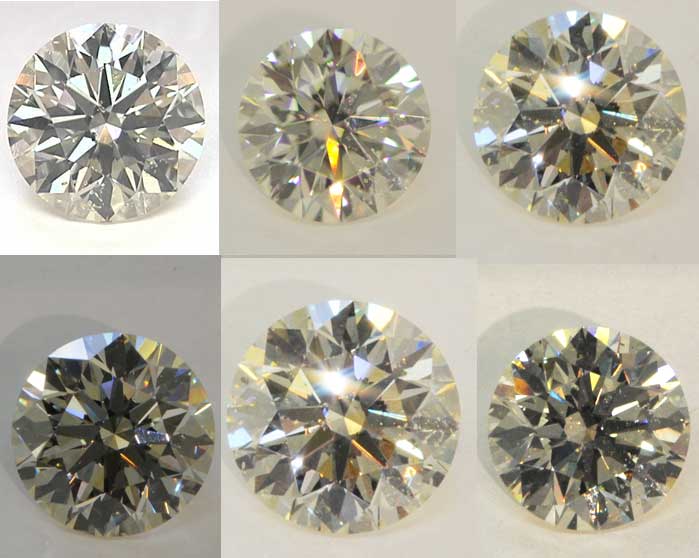
Now we have a better understanding of why what we see in the camera is not necessarily what we see with our eyes. In my KR222 the color of the diamond barely shows, which is much as I see it with my eye, but it fails to capture the dispersion I see with my eye.
I am 62 years old as I write this, and will see color differently than someone who is younger. Where I once scored 98% on my Munsel color test I would likely score lower now, and lower again when I reach 80.
As is clearly demonstrated above, my camera has trouble capturing color perfectly too. Perhaps a professional could get perfect color rendition on the pictures, I do not know.
What I do know is that clearly the camera is a tool that can allow me to show you much about the diamond, whether it be from a moving picture such as the video shown above, or from a still camera.
With the stills we can go for a look inside the gem, as with our loupe photos that we provide with each diamond, or with a glamour shot that shares some of the beauty of the diamond with the viewer.
I am including another picture for illustrations sake; you decide what is important to you in a photo. The center stone is a D color, the sides are F. I do not believe it is possible to accurately tell the color in the photos.

If asked to choose the most attractive photo three people might choose differently, and these are relatively close. Darkness, brightness, color, dispersion, sparkle… All depend on the equipment, lighting and settings.
Be Aware
Some sellers will have better cameras and better skills than some other sellers. Others may have lesser cameras and skills, but their diamonds may be just as beautiful.
Something I have not even touched on in this article is the use of supplemental enhancement devices like “star” filters which unnaturally enhance a diamond’s sparkle in photos – or adjustments made in a photo editing program. One only has to look on eBay to find examples of photos so-enhanced that they are probably not accurately depicting the gemstone in any environment. I personally will not use such enhancements but they are out there and in-use by some advertisers and sellers.
In closing, I would simply counsel you to remember that “real-world” photos and videos are useful, but not absolute as purchase-decision makers. They can to help you decide which diamonds you may wish to see live with your eyes, but it is YOUR eyes and not the camera’s that must be happy when the deal is done. To that end the camera may never lie, but it tells different truths.
Wink Jones
Graduate Gemologist
High Performance Diamonds
Discuss on the forum










